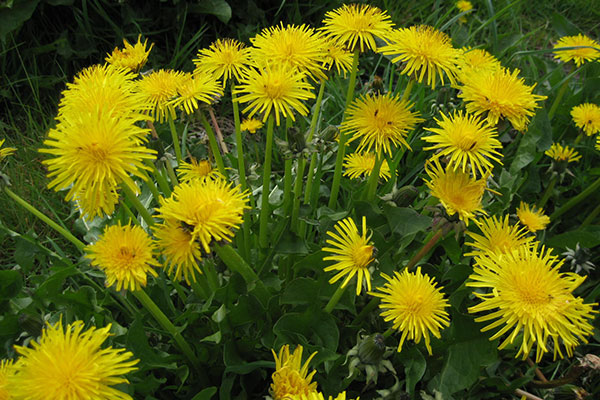Content
Dandelion is known to most gardeners as an annoying weed that can be found literally at every turn. But this unpretentious and affordable plant is of great value to humans. Information about the benefits and harms of dandelion root tea, flowers or herbs will help you understand how to apply for various diseases.
Why dandelion tea is good for you
Dandelion has a wide range of medicinal properties. It is almost impossible to list all of its therapeutic abilities. Here are just the main properties:
- choleretic;
- diuretic;
- laxative;
- sugar reducing;
- stimulating the activity of the pancreas;
- diaphoretic;
- antipyretic;
- anti-inflammatory;
- calming;
- antihistamine;
- antiviral;
- expectorant;
- anti-tuberculosis;
- cleansing;
- anthelmintic;
- tonic.
The pharmacological characteristics of a plant are dictated by its chemical composition. There is a high concentration of bitterness in the roots, therefore dandelion tea is used to normalize digestion processes, increase appetite, secretory and motor function of the gastrointestinal tract. The substances contained in tea irritate the receptors of the mucous membrane of the mouth and tongue, stimulate the work of the food center, and increase the secretion of the digestive glands.
Dandelion tea well cleanses the body of toxins, removes poisons and toxins. The drink is very useful for the hematopoietic system. Its use leads to a decrease in the concentration of harmful cholesterol, and in case of anemia, it restores a healthy balance of blood cells.
Dandelion roots are a part of diuretic, choleretic and laxative herbal preparations. They are used both independently and in complex treatment for cholecystitis, gastritis, complicated by regular constipation, dysfunction of the gallbladder. As evidenced by numerous reviews of dandelion root tea, the healing potential of this plant is truly limitless.
Is dandelion tea good for weight loss?
For overweight people, the benefits of dandelion leaf tea are manifested primarily in its diuretic properties. It helps to remove excess fluid from the body, which, accumulating in cells, interferes with the normal course of metabolic processes.
The drink also has a positive effect on the condition and function of the liver, cleansing accumulated toxins. As a result, the organ functions more efficiently, fully breaks down fats, and prevents excess cholesterol from being deposited.
Dandelion tea has a positive effect on the digestive processes and improves the digestion and absorption of food.
Can you drink dandelion during pregnancy?
Dandelion is not forbidden to drink during pregnancy, but its amount should not exceed the therapeutic doses recommended by the doctor.The drink will help solve many of the problems that women tend to worry about during this difficult period for them. Dandelion tea can:
- eliminate constipation;
- strengthen immunity;
- protect against viral, colds;
- prevent the threat of miscarriage;
- replenish the body with valuable nutrients.
Boil a tablespoon of a mixture of dried leaves and root for several minutes over low heat. Insist and take three times a day on an empty stomach. This infusion will help reduce the risk of termination of pregnancy. But a different recipe is suitable for nursing mothers.
To make more milk, you need to steam 1 tsp. dandelion root powder in a cup of boiling water, leave for an hour under the lid, it is better if you do it in a thermos. Take a spoonful before each meal.
What dandelion tea is made of
Dandelion is completely healing. To cure the most serious diseases will help not only the roots, but also the flowers and leaves of the plant. For the preparation of the drink, dry raw materials are used. Fresh herbs are more suitable for making vitamin salads, cocktails, juice.
Dandelion tea may contain additional ingredients. They are included in the recipe for different purposes:
- Improve the taste of the drink. Dandelion has a lot of bitterness, specific notes. To slightly tweak the flavor range, add additional components, herbs.
- Give the drink a rich vitamin or medicinal content, make it more active in influencing the body and its problem areas.
In addition, for the drink to be sweet and tasty, all kinds of sweeteners must be present in it. According to reviews, dandelion tea can be added not only to the usual sugar, but also honey, sweeteners (sucralose, stevioside), cane sugar, molasses and others.
What does dandelion work with when brewing tea?
It is good to add lemon, cranberries, kiwi, some other sour fruits or berries to dandelion tea to give it the sourness it needs. If you add honey to such a drink, you get a real cure for colds, to raise immunity, strengthen strength and prevent hypovitaminosis.
Procurement of raw materials
Dandelion must be harvested correctly in order to preserve its beneficial properties as much as possible. For different parts of the plant, there are different rules for collecting drying.
Root
Most of all medicinal substances are concentrated in dandelion roots. They are harvested either in early spring, when the plant is just beginning to gain strength, but has not yet bloomed, there are no leaves, or in the fall, during the wilting period.
It is better to extract the root from the ground with a shovel. Then shake off and wash in cold running water. Dry and dry for several days in the open air in the shade, until the milky juice ceases to appear on the slices.
To dry within a week should be in a room with a low percentage of humidity, well ventilated. You can do all this in a dryer, and so that the raw materials do not lose their useful properties, set the temperature regime to 40-50 degrees.
Flowers
The yellow dandelion heads must be harvested at the beginning of their flowering. The weather must be dry for at least a few days. Collect in the afternoon, so that traces of dew have disappeared on the flowers by this time.
Put the collected raw materials in one layer on a moisture-absorbing surface, for example, on sackcloth, paper. It is necessary to avoid direct sunlight, under the influence of which the plant will lose most of its beneficial properties. The flower heads should be turned over as often as possible to avoid rotting.
Leaves
The collection is carried out during the flowering period. Dried, like any other grass, in the shade, under a canopy or in a room with good air circulation. The leaves should be turned over from time to time so that they are weathered evenly from all sides.
How to make dandelion tea
The technology of making dandelion tea is not much different from the method of preparing similar hot drinks from herbs or traditional tea brewing. You will need 2 main components: vegetable raw materials and boiling water.
How to make dandelion flower tea
From the yellow dandelion heads, you can prepare a concentrate that will serve as the basis for making tea. It only needs to be diluted with a cup of warm boiled water and the drink is ready. Do it as follows.
In a 3 liter jar, lay the flower heads and granulated sugar in layers, which will need about 1.5 kg in total. Then tamp, add a little water (<100 ml). Soon, juice will begin to stand out, this is the basis for making tea.
How to make dandelion root tea
Grind the dried roots of the plant into powder. Steam a teaspoon of the resulting raw material with a cup of boiling water and leave for 10-20 minutes. Drink the entire volume during the day before meals, divided into 4 doses. Dandelion root tea will be beneficial for digestion, urinary and bile ducts, as well as diabetes, atherosclerosis and many other diseases.
How to make dandelion leaf tea
Consider the recipe for dandelion green tea. Pour the dry leaves of the plant into a cup (2 tsp), add a slice of lemon and pour boiling water over it. Infuse for 10-15 minutes, sweeten. The benefits and harms of tea made from dandelion leaves are taken into account in the medical practice of traditional healers and herbalists. The plant helps to maintain the state of the nervous, cardiovascular, biliary, urinary and other systems of the body.
How to make dandelion root tea with honey
Pour boiling water over 2 tsp. crushed roots. Cover the container with a lid, insist until the drink has cooled to a maximum temperature of +40 degrees. Only then add 1 tsp. natural honey, a little lemon juice. Stir the drink until the additional ingredients are completely dissolved.
How to make dandelion root tea in a thermos
The richest and healthiest dandelion tea is obtained according to the recipe for cooking in a thermos. To get the usual concentration of the drink, in this case, you can use not 2 tsp. infusion from the roots of the plant, and one for the same amount of water (cup).
Features of reception
Dandelion tea will maximize its beneficial properties if you drink it on an empty stomach. It is necessary to give the body enough time for the full assimilation of biologically active substances contained in the drink, as well as for them to be able to make the process of healing a particular problem point in the human body.
Therefore, to obtain the most beneficial effect, dandelion tea should be drunk regularly throughout the day, preferably on an empty stomach half an hour or an hour before a meal. It is advisable to stop eating meat, especially fatty, smoked meat for the duration of treatment, to switch to a vegetarian or dairy-vegetable diet. This will help improve the absorption of nutrients in the drink.
Also, while taking dandelion, you do not need to eat fried food, coffee, a lot of sweets, so as not to complicate the situation. Dandelion in combination with these products can show completely opposite properties and intensify the disease-causing process, so you need to be very careful.
For dandelion root tea to fully show its beneficial properties, it should be prepared without added sugar. If it is difficult to do without a sweetener, you can add stevia (herb) or honey when brewing when the drink is already cold.
Limitations and contraindications
Dandelion tea can be beneficial as well as harmful.Its use is contraindicated in gastritis, which occurs against a background of increased acidity, as well as in ulcerative lesions of the digestive tract (stomach, duodenum 12).
You need to be careful with medicinal tea for acute inflammatory diseases of the biliary tract. Increased bile secretion can complicate the health situation and with intestinal disorders, as it will contribute to the development of a laxative effect.
Dandelion cannot be combined with the following medicines:
- antacids (anti-acid);
- anticoagulants (blood thinners);
- diuretics (diuretics);
- hypoglycemic, enhances, which can lead to an attack of hypoglycemia;
- lithium - weakens the action;
- ciprofloxacin - interferes with assimilation.
Begin to introduce dandelion into the diet carefully, with small doses. Otherwise, the development of an unpredictable reaction of the body is possible. This is especially true for children.
Conclusion
The benefits and harms of tea made from dandelion root or other parts of the plant have long been known to people and are used in medicine. It is a very effective and at the same time affordable remedy for many diseases. With its help, you can improve your health for free, strengthen the body, get rid of worms, prevent viral, colds, and prevent the development of complex pathologies, such as cancer.













